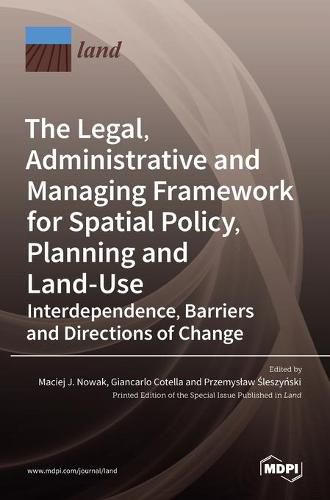Readings Newsletter
Become a Readings Member to make your shopping experience even easier.
Sign in or sign up for free!
You’re not far away from qualifying for FREE standard shipping within Australia
You’ve qualified for FREE standard shipping within Australia
The cart is loading…






This title is printed to order. This book may have been self-published. If so, we cannot guarantee the quality of the content. In the main most books will have gone through the editing process however some may not. We therefore suggest that you be aware of this before ordering this book. If in doubt check either the author or publisher’s details as we are unable to accept any returns unless they are faulty. Please contact us if you have any questions.
The book aims to explore the legal and administrative aspects of spatial governance and the challenges that their interaction entails. It does this through a number of chapters focusing on case studies located in different geographical areas of Europe and beyond. By doing this, the editors shed light on a set of challenges that emerge around the world at the intersection between the legal and administrative spheres during the governance and planning of territorial phenomena. The issues addressed in the various chapters highlight how spatial planning activities continue to face serious challenges that have not yet been satisfactorily addressed. In more detail, a correlation emerges between the legal regulations that allow and shape spatial-planning activities and the socio-economic and territorial challenges that those activities should tackle. This is often a consequence of the path-dependent influence of the traditional administrative and spatial planning configuration, which presents an inertial resistance to change that is hard to overcome. A similar situation arises concerning the mismatch between the boundaries of the existing administrative units and the extent of territorial phenomena, with a system of judicial-territorial administration that does not always coincide with the boundaries of the fundamental administrative division of a country, leading to an overall deterioration of the conditions in which all actors involved in spatial development operate.
$9.00 standard shipping within Australia
FREE standard shipping within Australia for orders over $100.00
Express & International shipping calculated at checkout
This title is printed to order. This book may have been self-published. If so, we cannot guarantee the quality of the content. In the main most books will have gone through the editing process however some may not. We therefore suggest that you be aware of this before ordering this book. If in doubt check either the author or publisher’s details as we are unable to accept any returns unless they are faulty. Please contact us if you have any questions.
The book aims to explore the legal and administrative aspects of spatial governance and the challenges that their interaction entails. It does this through a number of chapters focusing on case studies located in different geographical areas of Europe and beyond. By doing this, the editors shed light on a set of challenges that emerge around the world at the intersection between the legal and administrative spheres during the governance and planning of territorial phenomena. The issues addressed in the various chapters highlight how spatial planning activities continue to face serious challenges that have not yet been satisfactorily addressed. In more detail, a correlation emerges between the legal regulations that allow and shape spatial-planning activities and the socio-economic and territorial challenges that those activities should tackle. This is often a consequence of the path-dependent influence of the traditional administrative and spatial planning configuration, which presents an inertial resistance to change that is hard to overcome. A similar situation arises concerning the mismatch between the boundaries of the existing administrative units and the extent of territorial phenomena, with a system of judicial-territorial administration that does not always coincide with the boundaries of the fundamental administrative division of a country, leading to an overall deterioration of the conditions in which all actors involved in spatial development operate.